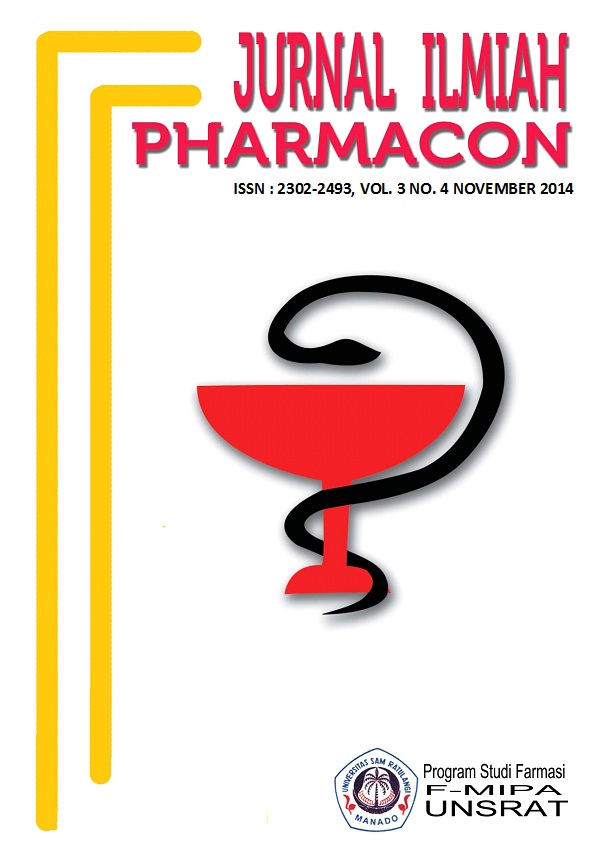Analisis Residu Klorpirifos Pada Sawi Hijau (Brassica Rapa Var.Parachinensis L.) Terhadap Parameter Waktu Retensi Metode Kromatografi Gas
DOI:
https://doi.org/10.35799/pha.3.2014.6574Abstract
Analisis Residu Klorpirifos Pada Sawi Hijau (Brassica Rapa Var.Parachinensis L.) Terhadap Parameter Waktu Retensi Metode Kromatografi Gas
Â
Asnah Marzuki1), Tajuddin Naid1), Risky S1)
1)Fakultas Farmasi Universitas Hasanuddin
.
ABSTRACT
The purposed of the research is analyzed the chlorpyrifos in green mustard of the retention time parameter with gas chromatography. The green mustard was collected of ready harvest condition with sample collecting point on diagonal form in the farm. As standard was used chlorpyrifos 99,9%. The research was begin with make the standard at 0,05 ppm and sample extraction was made duplo. Standard solution and sample was injected by rolling over in the gas chromatography with column of fused silica Rtx®-1 (Crossbond® dimetyl polisiloxan length 30 meter, inner diameter 0,25 mm and the partikel diameter of stationary phase fase diam 0,25 µm), electron capture detector, carrier gas nitrogen with flow rate 1,61 mL/min, conditioned at column temperature 250ºC, injector temperature 280ºC and detector temperature 300ºC and operating time for 15 minutes. The parameter was used is time retention (tR). the result showed at chromatogram in sample I and II, time retention was obtained similar with standard solution time retention although showed time retention difference above required limit while in sample I and II having the characteistic retention time of standard solution. The retention time based on gas chromatography method can be knew the concentration of chlorpyrifos as 1,0024 mg/kg but it still on tolerance threshold the maximum residue limits (MRL) is 0,1 mg/kg.
Â
Keywords: Chlorpyrifos, Brassica rapa var.parachinensis L,Time retention, Gas Chromatography
Â
ABSTRAK
Â
Telah dilakukan analisis residu Klorpirifos pada Sawi Hijau (Brassica Rapa Var. Parachinensis L.), terhadap parameter waktu retensi metode khromatografi gas pada sawi hijau (Brassica rapa var.parachinensis L.) secara kromatografi gas. Sawi hijau diambil pada kondisi siap panen dengan titik pengambilan sampel bentuk diagonal dari lahan. Sebagai standar digunakan klorpirifos 99,9 %. Penelitian diawali dengan pembuatan standar pada konsentrasi 0,05 bpj dan ekstraksi sampel dilakukan secara duplo. Larutan standar dansampel diinjeksikan secara bergantian ke dalam alat KG dengan kolom fused silica Rtx®-1 (Crossbond® dimetil polisiloksan panjang 30 meter, diameter dalam 0,25 mm dan diameter partikel fase diam 0,25 µm), detektor penangkap elektron (ECD), gas pembawa nitrogen dengan kecepatan alir 1,61 ml/menit, dikondisikan pada suhu kolom 250ºC, suhu injektor 280ºC dan suhu detektor 300ºC serta waktu pengoperasian selama 15 menit. Parameter yang digunakan dalam penelitian ini adalah waktu retensi (tR). Hasil analisis data menunjukkan pada kromatogram sampel I dan sampel ll, waktu retensi yang diperoleh hampir sama dengan waktu retensi darikromatogram larutan standar, walaupun tetap memperlihatkan perbedaan waktu retensi melebihi batas persyaratan. Sedangkan pada kromatogram sampei l dan sampel II diperoleh gambaran yang nilainya mendekati waktu retensipuncak khas pada standar. Waktu retensi menurut metode Kromatografi Gas,dapat diketahui kadar residu klorpirifos adalah 0,0024 mg/kg, tetapi masih dalam ambang toleransi BMR yakni 0,1 mg/kg.
Â
Kata kunci : Klorpirifos, Brassica rapa var.parachinensis L,Waktu Retensi, Kromatografi Gas
Â
Downloads
How to Cite
Issue
Section
License
Authors who publish with this journal agree to the following terms:
- Authors retain copyright and grant the journal right of first publication with the work simultaneously licensed under a Creative Commons Attribution-NonCommercial 4.0 International License that allows others to share the work with an acknowledgement of the work's authorship and initial publication in this journal.
- Authors are permitted and encouraged to post their work online (e.g., in institutional repositories or on their website) prior to and during the submission process, as it can lead to productive exchanges, as well as earlier and greater citation of published work (See The Effect of Open Access)










